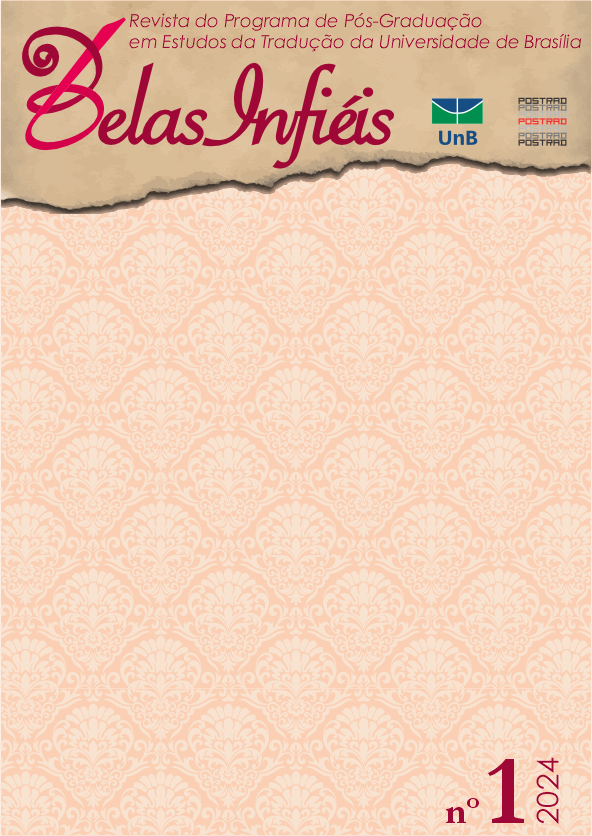A Brazilian Dracula: An Analysis of the Transposition of Gothic Features in Lúcio Cardoso’s Translation
DOI:
https://doi.org/10.26512/belasinfieis.v13.n1.2024.53023Keywords:
Translation. Gothic. Transposition of Gothic. Dracula. Lúcio Cardoso.Abstract
This paper aims to analyze the translation of Drácula: O Homem da Noite, by Lúcio Cardoso, made in 1943, in comparison to the 1897 source text, originally written by Bram Stoker. Cardoso’s translation has significant relevance for the field of Translation Studies, as it was the first to appear in Brazilian Portuguese and one of the first to attempt the challenging task of transporting the novel’s Gothic elements in translation. The theoretical basis consists of theories of the Gothic as a literary mode, based on Botting (1996), França (2017), Groom (2012), Hogle (2002) and Spooner (2007). The strategy for carrying out the analysis revolves around the comparison between the source text and Cardoso’s translation, observing how the translator works with the Gothic and which omissions of original excerpts are identified (or not) in his translation. Results obtained indicate that Cardoso’s translation is significantly different from the source text, to the point that it is not possible, at certain moments of the narrative, to find correspondences between the texts in aspects that make Dracula a Gothic novel, as mentioned by Hogle (2002).
Downloads
References
Aran, P. (2022). Gótico - gênero literário. In J. França, C. Reis, D. Roas, F. Furtado, & F. García (Eds.), Dicionário Digital do Insólito Ficcional (e-DDIF). 2. ed. Dialogarts. Disponível em: https://www.insolitoficcional.uerj.br/gotico-genero-literario/. Acesso em: 3 de março de 2023.
Barros, F. M. de. (2008). O Gótico e a Brasilidade em Lúcio Cardoso. Revista do Centro de Estudos Portugueses, 28(39), 113-131.
Bellas, J. P. (2020). Gótico Brasileiro: uma proposta de definição. Organon, 35(69), 1-15.
Botting, F. (1996). Gothic. Routledge.
Cardoso, L. (1943). Sou um Homem ou um Monstro? Revista Leitura, 4(1), 23 e 35. Disponível em: https://memoria.bn.gov.br/DocReader/docreader.aspx?bib=115509&pasta=ano%20194&pesq=&pagfis=2053 Acesso em: 07 ago. 2024.
Cohen, J. J. (ed.). (1996). Monster Theory. Reading Culture. University of Minnesota Press.
Dowling, L. (1979, 1 mar.). The Decadent and the New Woman in the 1890's. Nineteenth-Century Fiction, [S.L.], 33(4), 434-453. University of California Press. http://dx.doi.org/10.2307/2933251. Disponível em: https://www.jstor.org/stable/2933251?seq=1 Acesso em: 05 mar. 2023.
França, J. (2017). O sequestro do Gótico no Brasil. In L. Colucci, & J. França, As nuances do Gótico: do Setecentos à atualidade. Bonecker.
Groom, N. (2012). The Gothic: A Very Short Introduction. Oxford University Press.
Hogle, J. E. (2002). Introduction: The Gothic in Western Culture. In J. E. Hogle (Ed.), The Cambridge Companion to Gothic Fiction (pp. 1-20). Cambridge University Press.
Miles, R. (2002). The 1790s: the effulgence of Gothic. In J. E. Hogle (Ed.), The Cambridge Companion to Gothic Fiction (pp. 41-62). Cambridge University Press.
Resende, A. (2021). O Drácula de Lúcio Cardoso. Scripta Uniandrade, 19(3), 331-347.
Sá, D. S. de. (2010). Gótico Tropical: O Sublime e o Demoníaco em O Guarani [Dissertação de mestrado, EDUFBA].
Spooner, C. (2007). The Gothic in the Twentieth Century. In C. Spooner, & E. McEvoy (Eds.), The Routledge Companion to Gothic. Routledge.
Stoker, B. (2003). Dracula (2. ed.). Penguin Books.
Stoker, B. (2013). Drácula: O Homem da Noite. (L. Cardoso, trad.). Civilização Brasileira.
Stoker, B. (2018). Drácula. (M. Heloisa, trad.). Darkside.
Downloads
Published
How to Cite
Issue
Section
License
Copyright (c) 2024 CC BY

This work is licensed under a Creative Commons Attribution 4.0 International License.
Given the public access to this journal, the texts are free to use but requires the recognition of the original authorship and initial publication in this journal to be properly stated.
 The journal allows the use of works published for non-commercial purposes, including the right to submit the work to publicly accessible databases. Published contributions are the sole and exclusive responsibility of the author(s).Â



















